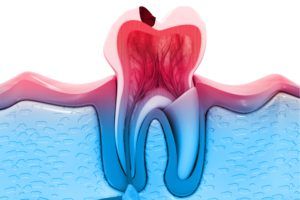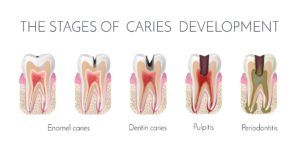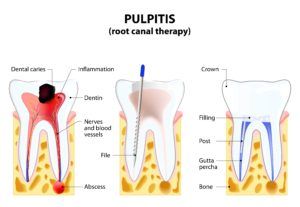Root Canals
Root canal treatment is required when the tooth’s pulp and roots are infected. Often times, this infection is the result of untreated tooth decay that has reached the innermost layer of the tooth. Infected pulp can cause tooth pain, swelling, and overall discomfort. By removing the infected tissue, root canal treatment restores the affected tooth and prevents it from eventual loss.
Did You Know?
Root canal treatments restore about 17 million teeth each year. By removing the diseased tissue, root canals prevent the need for a tooth extraction. This means that root canal treatment is also responsible for saving 17 million teeth each year.
Frequently Asked Questions:
Do I need root canal treatment?

You will need root canal treatment if your tooth’s pulp has become infected. Symptoms indicating the need for root canal treatment can include:
- Painful toothache (mild to severe)
- Swollen or inflamed gum tissue around the affected tooth
- Inability to chew or apply pressure to the affected tooth
- The tooth appears discolored
- Temperature sensitivity to hot and cold
Any of these symptoms could indicate a possible pulp infection and should be evaluated immediately. If you are experiencing any of these symptoms, schedule a consultation with Dr. Claudia Wood of Danforth Dental today.
Are root canals painful?
Although most people believe root canal treatment to be painful, root canals themselves are not painful. Rather it is the pulp infection that causes pain. Consider this. The pulp layer of your tooth contains nerves, blood, and lymph tissue. When it becomes infected, the pulp starts to die which triggers an inflammatory response from the body. This inflammatory response is the reason why your tooth starts hurting. Although root canals remove the infected tissue, it still takes a few days for the inflammation to go down. This means there may be some residual pain. However, this pain is the result of the previous infection, not root canal treatment. In fact, during your root canal treatment, you will be anesthetized and your mouth will be numb.
What causes pulp infections?
The most common cause for pulp infections are tooth decay. Your teeth have three layers: the enamel, dentin, and pulp layer. Enamel is the strongest layer, followed by dentin, and the pulp is the internal core. Enamel and dentin protect the pulp, however when tooth decay is able to permeate through these layers, bacteria is able to enter the pulp and cause an infection.

Although tooth decay is the most common reason, trauma resulting in a crack or chip can also allow bacteria to enter the pulp. Leaky fillings, crowns, or other dental restorations can also allow bacteria to enter the pulp.
Is there an alternative to root canal treatment?
The only alternative to root canal treatment is to have the infected tooth extracted. Once the pulp has become infected, the tooth can only be saved by removing the infection through a root canal or removing the tooth altogether. However, extractions are not often recommended because they are more invasive and costly. Root canal treatment is currently the safest and most effective way to remove infected pulp while preserving the tooth.
How is root canal treatment performed?
Before beginning your root canal procedure, Dr. Wood will take x-rays to determine the extent of the infection. She will then prepare your tooth for the procedure by isolating it with a dental dam. This makes the tooth easier to treat and prevents saliva from entering the treatment area. Your mouth will also be anesthetized with a local anesthetic to keep you comfortable during the procedure. In some cases, local anesthesia may also be used to keep you calm and still.
Once your tooth has been prepared and your mouth is numb, a small hole will be drilled in the top of your tooth in order to reach the pulp layer. Then, specialized root canal files will be inserted into the pulp chamber and root canals to remove the tooth’s nerve and the infected pulp tissue. After all the infected tissue has been removed, the remaining space will be flushed with water or sodium hypochlorite, which is an antiseptic. This will remove any additional debris and ensure that the pulp chamber and root canals are free of bacteria.
The remaining chamber and root canals will then be filled with a rubber-like material called gutta-percha. This root canal filling material is used to provide internal support for the tooth. Sometimes, a special post may also be placed inside the tooth to provide even more support. Root canal treatment is then concluded by placing a temporary filling over the gutta-percha. This temporary filling effectively seals the tooth until a permanent restoration can be placed.

Are there any post-treatment instructions I need to follow?
Yes, you will have certain post-treatment instructions to follow. After your root canal, you will need to avoid chewing on the side the procedure was performed on until a permanent restoration can be placed. Usually a dental crown will be placed once it is clear that your tooth has healed properly. It is important to have the dental crown placed as soon as possible.
You may also experience some minor soreness after root canal treatment. This is because the area is still inflamed from the initial infection. Any pain or soreness should fade within a few days once the inflammation heals. In the meantime, you can use over the counter pain medications if needed.
In some cases, root canal retreatment may be necessary if the tooth fails to heal or becomes infected again. Sometimes the tooth may not heal properly because it contained narrow or crooked canals that were not completely cleaned. Other times, the tooth can become infected in the future due to trauma, decay, or a faulty dental restoration.
How much do root canals cost?
The average cost of a root canal is about $500-$1,800. Root canals in molars tend to be on the more expensive end because the procedure is more difficult. There is also an additional cost for the dental crown, however this can vary depending on the materials used.
With dental insurance, you can expect partial coverage. Dental insurance plans classify root canal treatment as a restorative procedure and will often pay a percentage of the total cost. This amount will depend on your individual insurance company and our office will help you to determine what your level of coverage is before undergoing root canal treatment.
For dedicated and caring dental care, schedule a consultation with Dr. Claudia Wood of Danforth Dental Solutions. Danforth Dental Solutions is proud to serve Toronto and the surrounding areas.






